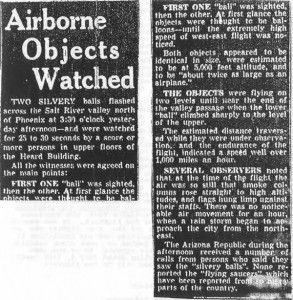THE NEW YORK TIMES. October 27, 1945. Page-1:
1,400-MILE SPEED IS ATTAINED BY SUPERSONIC FLYING DEVICES
By Russell Porter
Special to THE NEW YORK TIMES.
BUFFALO, Oct. 26–Special flying devices in the supersonic field, built for the Government in cooperation with other organizations, have attained speeds of 1,400 miles an hour, almost twice the speed of sound, Dr. C. C. Furnas, director of the Curtiss-Wright Research Laboratory, revealed here today.
Dr. Furnas said that he was speaking of true flying devices, not artillery shells or rockets and that they were being flown in tests “somewhere in the United States.” In some cases the devices have wings, and they do not depend on propellers or atomic energy for power, but this was about the only information that could be given about them, for reasons of military security.
“This is one place where we have not been behind the Germans in this sort of research,” said Dr. Furnas. “It shows we really mean business in the matter of speed, that it is not an academic subject with us. This is a landmark in aviation, leading right up to future developments that would have been considered strictly of Buck Rogers’s quality a few years ago. It is the development of an idea that is about 50 years old.”
He said that his company had been working on the project for a year and that it would be several years before it could be used importantly for military purposes. Perhaps twenty-five years from now, he said, it might be available for commercial passenger transportation, if people wanted to use it and were willing to pay the high costs of producing such devices, which he doubted. He thought 500 to 600 miles an hour probably would be the economically-practicable limit of future commercial aviation.
A new tele-metering system whereby pictures of the instrument panel are transmitted by television is being used to study the flights of the special devices.
Although the special devices are not man-carrying, which indicates they could be used as guided missiles to carry atomic bombs or other destructive forces, Dr. Furnas said that the research staff was studying the problem of pilot ejection from high-speed aircraft by jettisoning part of the structure within which the pilot would be safe.
If a pilot should jump from a plane flying at supersonic speed, he pointed out, sure death would result.
Dr. Furnas made his statement to a group of newspapermen making a tour of the country, arranged by the National Association of Manufacturers, to survey the progress of reconversion. They did not learn much about reconversion as such today since they visited nothing but aircraft plants, whose problem is not reconversion so much as a contraction from abnormally heavy wartime demands to peacetime production which is only a small fraction of war production.
After inspecting wind tunnels and altitude chambers in the Curtiss-Wright laboratory, the reporters visited the Bell Aircraft Corporation at Niagara Falls, N. Y., where they saw a demonstration of the helicopter, and some were chosen by lot to take short flights in one.
Lawrence D. Bell, the president, declared that his company’s plans for commercial aircraft production centered largely around the helicopter. In ten or fifteen years, he predicted, helicopters would become as large an industry as orthodox aircraft building and would take over and greatly enlarge the private plane market.
At present, however, he said, they had not been sufficiently developed structurally to be safe for private flying for the average person. This was largely due, he explained, to wartime restriction on their development for commercial and private use. Tremendous progress would be made in the next few years, he asserted.
There were only 300 to 500 helicopters in the world today, he went on. He intends to get into production sometime next year at the rate of fifty a month. The company is also engaged in experimental and development work on military aircraft.
The newspaper group flew here, from Akron, Ohio, this morning.
TIME – Science / Monday, Nov. 05, 1945
FASTER THAN SOUND
From Buffalo last week came a tantalizing fragment of news. Some sort of “special flying devices,” said Dr. C. C. Furnas, head of Curtiss-Wright’s research laboratory, had attained speeds of 1,400 m.p.h.—almost twice the speed of sound. When reporters quizzed him, Dr. Furnas added a few details. But he was far from specific about just what the “devices” were.
- They were not artillery shells or rockets, but actually flew, some of them with wings.
- They had been test-flown “somewhere in the U.S.”
- They did not use propellers or atomic energy.
- At present they did not carry pilots, but contained a television set that watched the instrument panel, thus permitting their flight to be observed in detail (see above). Apparently they were not expected to make safe landings, for Dr. Furnas spoke of designing detachable sections to allow a pilot to bail out. Jumping unprotected into a 1,400-m.p.h. slipstream would be sure death.
From “The Arizona Republic”, July 8, 1947

